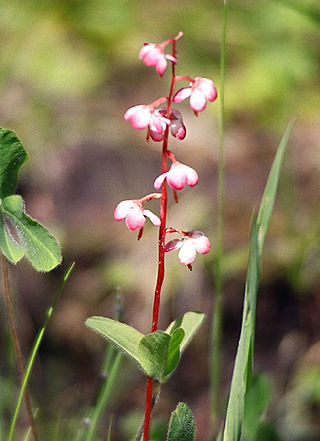
Pyrola is a genus of evergreen herbaceous plants in the family Ericaceae. Under the old Cronquist system it was placed in its own family Pyrolaceae, but genetic research showed it belonged in the family Ericaceae. The species are commonly known as wintergreen, a name shared with several other related and unrelated plants. They are native to northern temperate and Arctic regions.
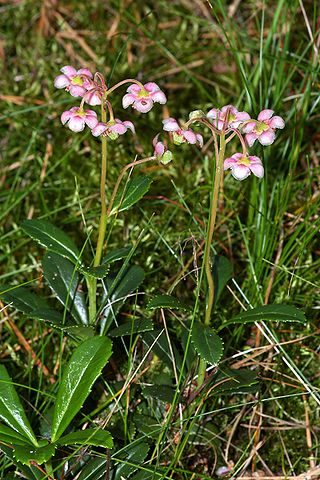
Chimaphila umbellata, the umbellate wintergreen, pipsissewa, or prince's pine, is a small perennial flowering plant found in dry woodlands, or sandy soils. It is native throughout the cool temperate Northern Hemisphere.
Wintergreen is a group of aromatic plants, many in the genus Gaultheria.

Pyrola media, the intermediate wintergreen, is a flowering plant in the genus Pyrola, native to northern and eastern Europe and Western Asia.

Pyrola chlorantha, the greenflowered wintergreen, is a species of the plant genus Pyrola. It has a circumboreal distribution and is found throughout the northern latitudes of Eurasia and North America.
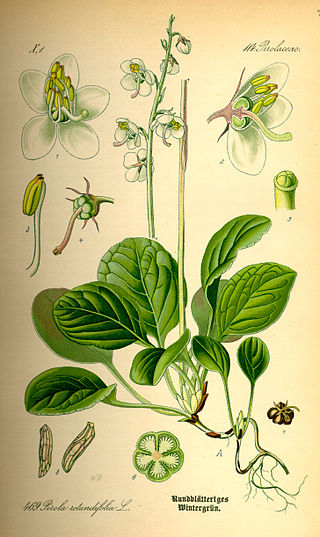
Pyrola rotundifolia, the round-leaved wintergreen, is a plant species of the genus Pyrola. It is found in Europe, Japan, Mongolia, Myanmar and Russia.

Pyrola asarifolia, commonly known as liverleaf wintergreen, bog wintergreen or pink wintergreen, is a plant species of the genus Pyrola native to western North America. It is found primarily on forest margins at mid latitude in the Pacific Northwest and northern California. It is so named simply because its leaves maintain their green color through winter.

Pyrola minor, known by the common names snowline wintergreen, lesser wintergreen, and common wintergreen, is a plant species of the genus Pyrola. It is a perennial herb or subshrub growing up to 1 ft (0.30 m) tall. It has a Circumboreal distribution and can be found throughout the northern latitudes of Eurasia and North America. Its leaves are simple and basal in arrangement. It grows in moist areas. Flowers have five petals that are pale pink to rose in color. Flowers bloom June to August.

Eriogonum pyrolifolium is a species of wild buckwheat. It is native to western North America, from British Columbia to the high mountains of California.
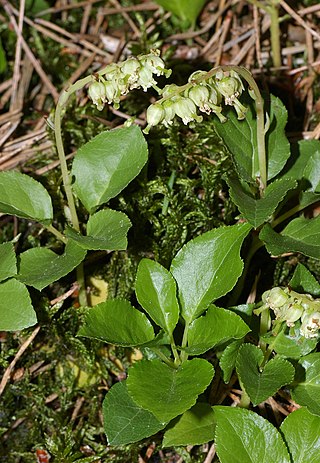
Orthilia is a genus of flowering plants in the family Ericaceae. It has only one species, Orthilia secunda. Its common names are sidebells wintergreen, one-sided-wintergreen and serrated-wintergreen. It is also called one-sided pyrola, one-sided shinleaf, and one-sided wintergreen. It was previously part of genus Pyrola, the wintergreens.

Silene menziesii is a species of flowering plant in the family Caryophyllaceae known by the common names Menzies' campion and Menzies' catchfly. It is native to western North America from Alaska through the western half of Canada to the southwestern United States. It can be found in many types of habitat and it is quite common in much of its range. It is variable in morphology and there are a number of varied subtaxa. In general, it is a perennial herb growing from a caudex, appearing matlike, decumbent, or erect, with stems a few centimeters to over half a meter long. It is usually hairy in texture, with upper parts bearing sticky glandular hairs. The leaves are lance-shaped, oppositely arranged in pairs, and a few centimeters in length, upper leaves usually smaller than lower. Flowers may occur in a cyme at the top of the stem, or in leaf axils, or both. Each is encapsulated in a hairy, veined calyx of fused sepals. The petals are white with two lobes at the tips. The plant is dioecious with male and female plants producing different flowers. The male and female flower types look the same externally; the stamens are reduced in female plants and the stigmas are reduced in the male.
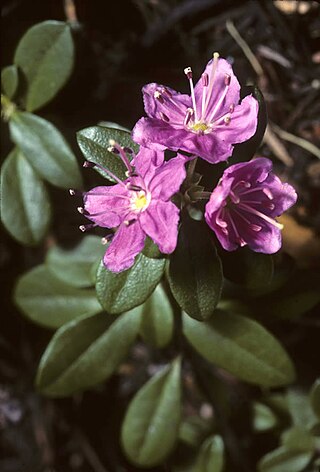
Kalmiopsis fragrans is a rare species of flowering plant in the heath family known by the common name North Umpqua kalmiopsis. It is endemic to Oregon in the United States, where there are just a few known populations, all within Douglas County.
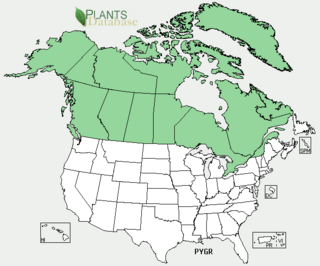
Pyrola grandiflora (, commonly known as Arctic wintergreen or largeflowered wintergreen, is a hardy perennial evergreen subshrub in the family Ericaceae. It is widely distributed in the Northern Hemisphere from temperate to tundra-like climates.

Pyrola americana, the American wintergreen, is a plant species native to Canada and the United States. It has been reported from every Canadian province from Newfoundland to Manitoba, as well as from St. Pierre & Miquelon plus the northeastern US from Maine south along the Appalachian Mountains to extreme northeastern Tennessee. It also occurs in all the Great Lakes states and in the Black Hills of South Dakota. It grows in moist forests up to an elevation of 2100 m.
The spruce cone rust, caused by the rust fungus Chrysomyxa pirolata Wint., affects spruces in 3 continents, including white spruce in Canada. Alternate hosts of the fungus are several species among 3 genera of wintergreen: Pyrola spp., Orthilia spp., and Moneses spp.. Diseased cones open prematurely and orange-yellow aeciospores are sometimes produced in such quantity as to color the forest floor and lake surfaces. Up to half of a cone crop can be affected, and most of the affected cones do not produce viable seed. Some localities commonly experience damage to 20% to 30% of cone crops, a factor to be considered in the siting of seed orchards.
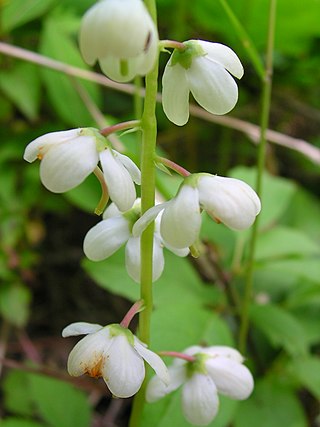
Pyrola elliptica, known as shinleaf, shinleaf pyrola, waxflower shinleaf, elliptic shineleaf and white wintergreen is a species of heath.

Pyrola crypta, commonly known as cryptic wintergreen, is a perennial herb in the heath family.
















